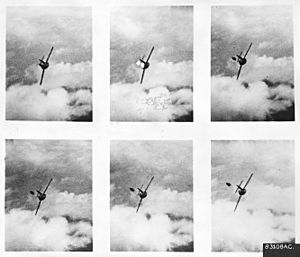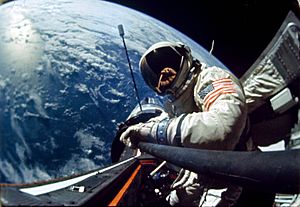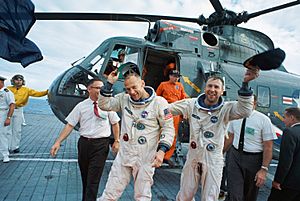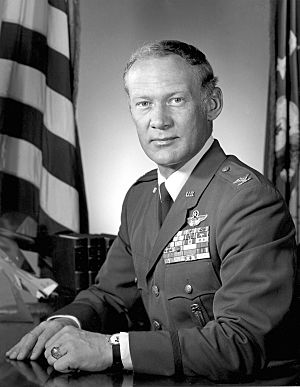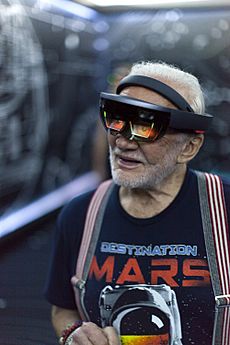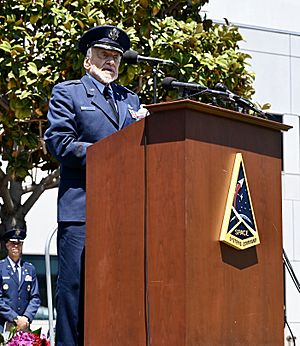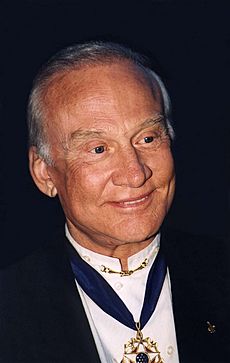Buzz Aldrin facts for kids
Quick facts for kids
Buzz Aldrin
|
|
|---|---|
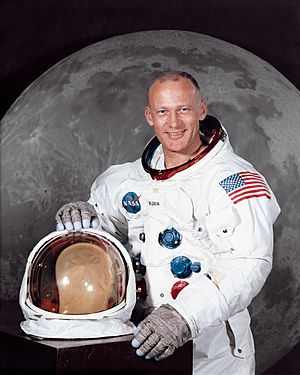
Aldrin in 1969
|
|
| Born |
Edwin Eugene Aldrin Jr.
January 20, 1930 Glen Ridge, New Jersey, U.S.
|
| Other names | Dr. Rendezvous |
| Awards |
|
| Space career | |
| NASA astronaut | |
| Rank | Brigadier General, USAF |
|
Time in space
|
12d 1h 53m |
| Selection | NASA Group 3 (1963) |
|
Total EVAs
|
4 |
|
Total EVA time
|
7h 52m |
| Missions |
|
|
Mission insignia
|
 |
| Retirement | July 1, 1971 |
| Scientific career | |
| Thesis | Line-of-Sight Guidance Techniques for Manned Orbital Rendezvous (1963) |
| Doctoral advisors |
|
| Signature | |
Buzz Aldrin (born Edwin Eugene Aldrin Jr.; January 20, 1930) is an American former astronaut, engineer, and fighter pilot. He is famous for making three spacewalks during the 1966 Gemini 12 mission. He was also the pilot of the Lunar Module Eagle on the 1969 Apollo 11 mission. Buzz Aldrin was the second person to walk on the Moon, right after mission commander Neil Armstrong.
Born in Glen Ridge, New Jersey, Aldrin graduated from the United States Military Academy at West Point in 1951. He earned a degree in mechanical engineering. He then joined the United States Air Force and became a jet fighter pilot. He flew 66 combat missions during the Korean War and shot down two enemy planes.
After getting a special science degree in astronautics from the Massachusetts Institute of Technology (MIT), Aldrin was chosen by NASA to be part of Astronaut Group 3. He was the first astronaut with a doctoral degree. His research on how spacecraft meet up in orbit earned him the nickname "Dr. Rendezvous." His first trip to space was in 1966 on Gemini 12. During this mission, he spent over five hours outside the spacecraft. Three years later, Aldrin stepped onto the Moon on July 21, 1969, just nineteen minutes after Neil Armstrong.
After leaving NASA in 1971, Aldrin continued to support space exploration. He especially pushed for a human mission to Mars. He even created a special spacecraft path called the Aldrin cycler. This path makes travel to Mars more efficient. He has received many awards, including the Presidential Medal of Freedom in 1969.
Contents
Early Life and Education
Buzz Aldrin was born Edwin Eugene Aldrin Jr. on January 20, 1930, in Glen Ridge, New Jersey. His parents were Edwin Eugene Aldrin Sr. and Marion Aldrin. His father was an Army aviator during World War I. Buzz got his nickname because his older sister, Fay Ann, mispronounced "brother" as "buzzer." He later made "Buzz" his legal first name in 1988.
Buzz was a Boy Scout and did very well in school. He was also a talented football player. He was the starting center for his high school team that won the state championship in 1946. His father wanted him to go to the United States Naval Academy. However, Buzz preferred flying airplanes and chose the United States Military Academy at West Point, New York instead.
Aldrin started at West Point in 1947. He was an excellent student, finishing first in his class during his first year. He was also a great athlete, competing in pole vault for the track and field team. In 1951, Aldrin graduated third in his class. He earned a Bachelor of Science degree in mechanical engineering.
Military Service
After graduating from West Point, Aldrin chose to join the United States Air Force. He became a second lieutenant and began his flight training. He learned to fly different types of jet planes, including the F-86 Sabre.
In December 1952, Aldrin was sent to Korea to fly combat missions during the Korean War. He flew 66 missions in F-86 Sabres. He successfully shot down two MiG-15 enemy aircraft. One of his victories was even featured in Life magazine, showing gun camera footage of the enemy pilot ejecting.
For his service in Korea, Aldrin received two Distinguished Flying Crosses and three Air Medals. After his year-long tour, he became an aerial gunnery instructor. He also served as an aide-de-camp at the new United States Air Force Academy.
From 1956 to 1959, he flew F-100 Super Sabres in West Germany. One of his colleagues was Ed White, who later became an astronaut. White encouraged Aldrin to pursue a master's degree.
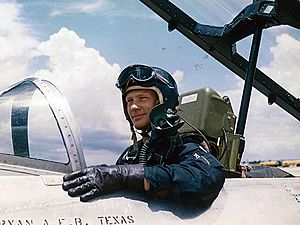
Through the Air Force Institute of Technology, Aldrin enrolled at the Massachusetts Institute of Technology (MIT) in 1959. He decided to pursue a doctorate degree. In January 1963, he earned a special science degree in astronautics. His doctoral research was about how spacecraft meet up in orbit. He hoped this work would help him become an astronaut.
After getting his doctorate, Aldrin worked with NASA's Project Gemini. He helped integrate Department of Defense experiments into the Gemini flights.
NASA Career
Aldrin first tried to join the astronaut team in 1962 but was not accepted because he was not a test pilot. However, in 1963, NASA changed the rules. They allowed applicants with a lot of flying experience in jet aircraft. Aldrin had over 2,500 hours of flying time.
On October 18, 1963, Aldrin was selected as one of fourteen members of NASA's Astronaut Group 3. This made him the first astronaut with a doctoral degree. His deep knowledge of how things move in orbit earned him the nickname "Dr. Rendezvous" from his fellow astronauts. After his training, Aldrin became an expert in mission planning and flight paths.
Gemini Program
Jim Lovell and Aldrin were chosen as the backup crew for Gemini 10. Backup crews often became the main crew for later missions. Due to an accident involving another crew, Lovell and Aldrin were moved up to be the main crew for Gemini 12. They were officially assigned to Gemini 12 on June 17, 1966.
Gemini 12 Mission
Gemini 12 was the last mission in the Gemini program. Its main goal was to complete tasks that had been difficult on earlier missions. NASA was especially concerned about extravehicular activity (EVA), or spacewalks. Previous astronauts had gotten very tired during spacewalks.
To help Aldrin succeed, NASA changed the training. They focused on underwater training instead of parabolic flight. Underwater training gave a better feeling of being weightless. NASA also added more handholds to the spacecraft and created special places where Aldrin could anchor his feet.
The main goals of Gemini 12 were to meet up with a target vehicle, fly the spacecraft and target vehicle together, and perform three spacewalks. The mission also carried 14 scientific experiments.
Gemini 12 launched on November 11, 1966. The first big goal was to meet up with the target vehicle. When the radar stopped working, Aldrin used a sextant and special charts he helped create. This allowed Lovell to guide the spacecraft to successfully dock with the target vehicle.
Aldrin performed three spacewalks. The first was a "standup" EVA on November 12. He opened the spacecraft door and stood up, staying inside. This helped him practice for his free-flight spacewalk. This standup EVA lasted two hours and twenty minutes, setting a new record.
The next day, Aldrin performed his free-flight EVA. He moved along the spacecraft to the target vehicle and set up equipment. He did many tasks, like connecting electrical parts and testing tools for the future Project Apollo. He took short rest periods to avoid getting tired. This spacewalk lasted two hours and six minutes. A third, shorter standup EVA was done on November 14 for photos and experiments.
On November 15, the crew returned to Earth. They landed in the Atlantic Ocean and were picked up by a helicopter. They were then taken to the aircraft carrier USS Wasp.
Apollo Program
Aldrin was assigned to an Apollo crew with Neil Armstrong as commander and Michael Collins as command module pilot. Aldrin was the lunar module pilot. This crew was the backup for Apollo 9 and later Apollo 8. According to the usual crew rotation, Armstrong's crew was expected to fly Apollo 11.

Apollo 11 was a special mission because all its astronauts had already flown in space. There was a discussion about who would be the first to step on the Moon. While early plans suggested the lunar module pilot (Aldrin) would go first, it was decided that Armstrong, as commander, would be the first. This was also easier due to the layout inside the lunar lander.
Aldrin and Armstrong did not have much time for geology training. The main goal of the first lunar landing was to land safely and return to Earth. They did take one field trip to West Texas to practice.
Apollo 11 Mission
On July 16, 1969, Apollo 11 launched from Cape Canaveral, Florida. Millions of people watched the launch live around the world. The Saturn V rocket propelled Apollo 11 into Earth orbit. After a short time, the spacecraft began its journey toward the Moon.
On July 19, Apollo 11 went behind the Moon and entered lunar orbit. The crew saw their landing site in the southern Sea of Tranquillity. On July 20, Aldrin and Armstrong entered the lunar module, Eagle. At 17:44:00 UTC, Eagle separated from the command module, Columbia, where Collins remained.
During the descent, Aldrin called out navigation data to Armstrong, who was piloting Eagle. The computer gave some alarms, but Armstrong took manual control. The Eagle landed on the Moon at 20:17:40 UTC on Sunday, July 20, with only about 25 seconds of fuel left.
Aldrin, a Presbyterian elder, held a private religious ceremony on the Moon. He took communion and read words from the New Testament. He later said he wished he had chosen a more universal way to mark the moment.

Preparations for the spacewalk began. The hatch was opened at 02:39:33 on July 21. Aldrin stepped onto the Moon at 03:15:16 UTC on July 21, 1969. This was nineteen minutes after Armstrong. Aldrin's first words on the Moon were "Beautiful view." He and Armstrong then set up the Lunar Flag Assembly. Aldrin saluted the flag while Armstrong took a photo.
Aldrin experimented with different ways to move on the Moon's surface. During this time, President Nixon called them to congratulate them. After the call, Aldrin photographed and inspected the spacecraft. They also set up a seismometer to detect moonquakes and a laser beam reflector. Aldrin worked to get a core sample of the lunar surface. Most of the famous photos of an astronaut on the Moon from Apollo 11 are of Aldrin.
Aldrin reentered Eagle first. They then lifted film and 21.55 kg (47.5 lb) of lunar material into the spacecraft. They also left behind their backpacks and other equipment to make the ascent stage lighter. The hatch was closed, and they rested.

At 17:54 UTC, they lifted off in Eagle's ascent stage to rejoin Collins in Columbia. After meeting up, the ascent stage was released into lunar orbit. Columbia then headed back to Earth. It landed in the Pacific Ocean on July 24. The entire mission lasted 195 hours, 18 minutes, and 35 seconds.
To prevent any possible germs from the Moon, the astronauts were put into quarantine for 21 days. On August 13, the three astronauts were honored with parades in New York and Chicago. President Richard Nixon gave them the highest American civilian award, the Presidential Medal of Freedom.
On September 16, 1969, the astronauts spoke to Congress. They thanked them for their support and asked for continued funding for space. The astronauts then went on a 38-day world tour, visiting 22 countries.
After Apollo 11, Aldrin was very busy giving speeches. He also helped with the design of the Space Shuttle. With the Apollo program ending, Aldrin decided to return to the Air Force on July 1, 1971. During his time at NASA, he spent almost 290 hours in space.
Post-NASA Activities
Aldrin became the Commandant of the U.S. Air Force Test Pilot School at Edwards Air Force Base, California. This school trained pilots, including some for astronaut roles. Aldrin retired from the Air Force as a colonel on March 1, 1972, after 21 years of service.
Bart Sibrel Incident
On September 9, 2002, Aldrin was approached by a Moon landing conspiracy theorist named Bart Sibrel. Sibrel demanded that Aldrin swear on a Bible that the Moon landings were real. Aldrin, who was 72 years old, reacted by punching Sibrel. Witnesses said Sibrel had provoked Aldrin. The police decided not to press charges against Aldrin.
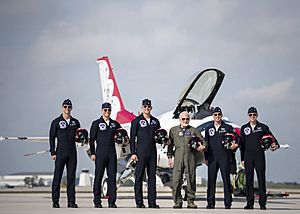
Unidentified Object Sighting
In 2005, Aldrin was interviewed for a documentary. He mentioned that the Apollo 11 crew had seen an unidentified object. However, the documentary did not include the crew's conclusion. The crew believed they had seen one of the four panels that detached from the Saturn V rocket. Aldrin later clarified that they were "99.9 percent" sure the object was this detached panel. He asked the Science Channel to correct the information, but they refused.
Polar Expedition
In December 2016, Aldrin visited the Amundsen–Scott South Pole Station in Antarctica. At 86 years old, he became the oldest person to reach the South Pole. He had also traveled to the North Pole in 1998.
Mission to Mars Advocacy
After leaving NASA, Aldrin continued to be a strong supporter of space exploration. He joined the University of North Dakota's College of Aerospace Sciences in 1985. He helped develop their Space Studies program. To promote space exploration, Aldrin worked with musicians to create a rap song and video called "Rocket Experience." The money from this was donated to his non-profit foundation, ShareSpace. He is also a member of the Mars Society's Steering committee.
In 1985, Aldrin suggested a special spacecraft trajectory known as the Aldrin cycler. This path could make travel to Mars more affordable by using less fuel. The Aldrin cycler would allow a five-and-a-half-month journey to Mars. Aldrin continues to research this idea with engineers. In 1996, he started a company called Starcraft Boosters, Inc. (SBI) to design reusable rockets.
In 2013, Aldrin wrote an article in The New York Times supporting a human mission to Mars. He saw the Moon as a starting point for humanity to travel to Mars and become a "two-planet species." In 2015, Aldrin presented a plan to NASA. This plan suggested that astronauts could establish a colony on Mars before the year 2040.
Awards and Honors
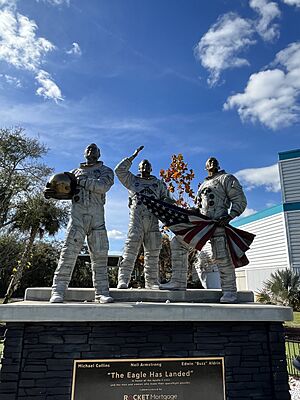
Aldrin has received many awards for his service. He was awarded the Air Force Distinguished Service Medal in 1969 for his role in Apollo 11. He also received the NASA Exceptional Service Medal and the NASA Distinguished Service Medal.
Aldrin has been honored in several halls of fame. He was inducted into the International Space Hall of Fame in 1982. He also joined the U.S. Astronaut Hall of Fame in 1993 and the National Aviation Hall of Fame in 2000.
The character Buzz Lightyear from the Toy Story movies was named in honor of Buzz Aldrin.
In 1999, the Apollo 11 crew received the Smithsonian Institution's Langley Gold Medal for aviation. In 2011, the Apollo 11 crew was awarded the New Frontier Congressional Gold Medal.
The Apollo 11 crew also received the Collier Trophy in 1969. They were named winners of the 1970 Dr. Robert H. Goddard Memorial Trophy for their great achievement in spaceflight. They also received the international Harmon Trophy and the Hubbard Medal. They were told they had "won a place alongside Christopher Columbus in American history."
In 2001, President George W. Bush appointed Aldrin to a commission on the future of the United States aerospace industry. In 2006, the Space Foundation gave him its highest honor, the General James E. Hill Lifetime Space Achievement Award.
Aldrin has received honorary degrees from six universities. He was named Chancellor of the International Space University in 2015. His hometown middle school in Montclair, New Jersey, was renamed Buzz Aldrin Middle School in 2016. A crater on the Moon and an asteroid are also named in his honor.
In 2019, Aldrin received the Stephen Hawking Medal for Science Communication. On his 93rd birthday, he was honored by Living Legends of Aviation. On May 5, 2023, he received an honorary promotion to brigadier general in the United States Air Force. He was also made an honorary Space Force guardian.
Personal Life
Marriages and Family
Buzz Aldrin has been married four times. His first marriage was to Joan Archer in 1954. They had three children: James, Janice, and Andrew. They divorced in 1974. His second wife was Beverly Van Zile, whom he married in 1975 and divorced in 1978. His third wife was Lois Driggs Cannon, whom he married in 1988. They divorced in 2012.
On January 20, 2023, his 93rd birthday, Aldrin announced that he had married for the fourth time to Anca Faur.
Politics

Aldrin is an active supporter of the Republican Party. He has attended fundraisers and supported candidates. He appeared as a guest of President Donald Trump at the 2019 State of the Union Address.
In the 2024 presidential election, he supported Donald Trump. Aldrin said he believed Trump's focus on space exploration was important for the nation's future.
Freemasonry
Buzz Aldrin is the first Freemason to set foot on the Moon. He joined Freemasonry in Alabama and Colorado.
When he walked on the Moon, Aldrin was a member of two Masonic lodges: Montclair Lodge No. 144 in New Jersey and Clear Lake Lodge No. 1417 in Seabrook, Texas. He also holds a high rank in the Ancient and Accepted Scottish Rite.
Aldrin is also a member of York Rite and Arabia Shrine Temple of Houston.
In the Media
Film and Television Roles
| Year | Title | Role | Notes |
|---|---|---|---|
| 1976 | The Boy in the Plastic Bubble | Himself | TV movie |
| 1986 | Punky Brewster | Himself | episode "Accidents Happen" |
| 1989 | After Dark | Himself | British discussion program |
| 1994 | The Simpsons | Himself (voice) | Episode: "Deep Space Homer" |
| 1997 | Space Ghost Coast to Coast | Himself | |
| 1999 | Disney's Recess | Himself (voice) | Episode: "Space Cadet" |
| 2003 | Da Ali G Show | Himself | 2 episodes |
| 2006 | Numb3rs | Himself | Episode: "Killer Chat" |
| 2007 | In the Shadow of the Moon | Himself | Documentary |
| 2008 | Fly Me to the Moon | Himself | |
| 2010 | 30 Rock | Himself | Episode: "The Moms" |
| 2010 | Dancing with the Stars | Himself/contestant | |
| 2011 | Transformers: Dark of the Moon | Himself | |
| 2011 | Futurama | Himself (voice) | Episode: "Cold Warriors" |
| 2012 | Space Brothers | Himself | |
| 2012 | The Big Bang Theory | Himself | Episode: "The Holographic Excitation" |
| 2012 | Mass Effect 3 | The Stargazer (voice) | Video game role |
| 2015 | Jorden runt på 6 steg | Himself | |
| 2016 | The Late Show with Stephen Colbert | Himself | Interview and skit |
| 2016 | Hell's Kitchen | Himself | Dining room guest |
| 2017 | Miles from Tomorrowland | Commander Copernicus (voice) | Guest stars in an episode |
Portrayed by Others
Aldrin has been played by actors in various films and TV shows:
- Cliff Robertson in Return to Earth (1976)
- Larry Williams in Apollo 13 (1995)
- Xander Berkeley in Apollo 11 (1996)
- Bryan Cranston in From the Earth to the Moon (1998) and Magnificent Desolation: Walking on the Moon 3D (2005)
- James Marsters in Moonshot (2009)
- Cory Tucker as a younger Buzz Aldrin in Transformers: Dark of the Moon (2011)
- Corey Stoll in First Man (2018)
- Chris Agos in For All Mankind (2019)
- Felix Scott in The Crown (2019)
- Roger Craig Smith and Henry Winkler in Inside Job (2021–2022)
- Bryn Thomas in Indiana Jones and the Dial of Destiny (2023)
- Colin Woodell in Fly Me to the Moon (2024)
Video Games
- Aldrin was a consultant for the video game Buzz Aldrin's Race Into Space (1993).
Works
- Aldrin, Edwin E. Jr. 1970. "Footsteps on the Moon". Edison Electric Institute Bulletin.
- Armstrong, Neil; Michael Collins; Edwin E. Aldrin; Gene Farmer; and Dora Jane Hamblin. 1970. First on the Moon: A Voyage with Neil Armstrong, Michael Collins, Edwin E. Aldrin Jr.
- Aldrin, Buzz and Wayne Warga. 1973. Return to Earth.
- Aldrin, Buzz and Malcolm McConnell. 1989. Men from Earth.
- Aldrin, Buzz and John Barnes. 1996. Encounter with Tiber.
- Aldrin, Buzz and John Barnes. 2000. The Return.
- Aldrin, Buzz and Wendell Minor. 2005. Reaching for the Moon.
- Aldrin, Buzz and Ken Abraham. 2009. Magnificent Desolation: The Long Journey Home from the Moon.
- Aldrin, Buzz and Wendell Minor. 2009. Look to the Stars.
- Aldrin, Buzz and Leonard David. 2013. Mission to Mars: My Vision for Space Exploration.
- Aldrin, Buzz and Marianne Dyson. 2015. Welcome to Mars: Making a Home on the Red Planet.
- Aldrin, Buzz and Ken Abraham. 2016. No Dream Is Too High: Life Lessons from a Man Who Walked on the Moon.
See also
 In Spanish: Buzz Aldrin para niños
In Spanish: Buzz Aldrin para niños
- Apollo 11 in popular culture
- List of spaceflight records
- History of aviation



